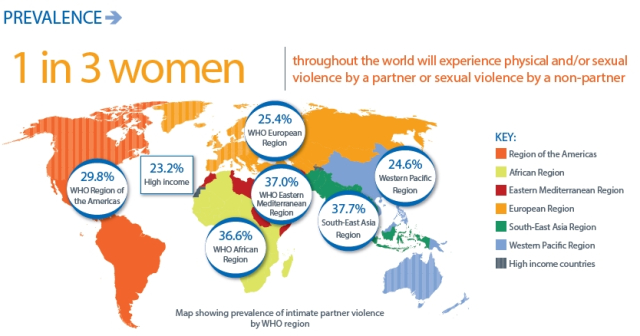
Key facts
Violence against women – particularly intimate partner violence and sexual violence – is a major public health problem and a violation of women’s human rights.
Global estimates published by WHO indicate that about 1 in 3 (35%) of women worldwide have experienced either physical and/or sexual intimate partner violence or non-partner sexual violence in their lifetime.
Most of this violence is intimate partner violence. Worldwide, almost one third (30%) of women who have been in a relationship report that they have experienced some form of physical and/or sexual violence by their intimate partner in their lifetime.
Globally, as many as 38% of murders of women are committed by a male intimate partner.
Violence can negatively affect women’s physical, mental, sexual, and reproductive health, and may increase the risk of acquiring HIV in some settings.
Men are more likely to perpetrate violence if they have low education, a history of child maltreatment, exposure to domestic violence against their mothers, harmful use of alcohol, unequal gender norms including attitudes accepting of violence, and a sense of entitlement over women.
Women are more likely to experience intimate partner violence if they have low education, exposure to mothers being abused by a partner, abuse during childhood, and attitudes accepting violence, male privilege, and women’s subordinate status.There is evidence that advocacy and empowerment counselling interventions, as well as home visitation are promising in preventing or reducing intimate partner violence against women.
Situations of conflict, post conflict and displacement may exacerbate existing violence, such as by intimate partners, as well as and non-partner sexual violence, and may also lead to new forms of violence against women.
Introduction
The United Nations defines violence against women as “any act of gender-based violence that results in, or is likely to result in, physical, sexual, or mental harm or suffering to women, including threats of such acts, coercion or arbitrary deprivation of liberty, whether occurring in public or in private life.” (1)
Intimate partner violence refers to behaviour by an intimate partner or ex-partner that causes physical, sexual or psychological harm, including physical aggression, sexual coercion, psychological abuse and controlling behaviours.
Sexual violence is “any sexual act, attempt to obtain a sexual act, or other act directed against a person’s sexuality using coercion, by any person regardless of their relationship to the victim, in any setting. It includes rape, defined as the physically forced or otherwise coerced penetration of the vulva or anus with a penis, other body part or object.”
World report on violence and health
Scope of the problem
Population-level surveys based on reports from victims provide the most accurate estimates of the prevalence of intimate partner violence and sexual violence. A 2013 analysis conduct by WHO with the London School of Hygiene and Tropical Medicine and the South Africa Medical Research Council, used existing data from over 80 countries and found that worldwide, 1 in 3, or 35%, of women have experienced physical and/or sexual violence by an intimate partner or non-partner sexual violence (3).
Global and regional estimates of violence against women
Almost one third (30%) of all women who have been in a relationship have experienced physical and/or sexual violence by their intimate partner. The prevalence estimates of intimate partner violence range from 23.2% in high-income countries and 24.6% in the WHO Western Pacific region to 37% in the WHO Eastern Mediterranean region, and 37.7% in the WHO South-East Asia region.
Globally as many as 38% of all murders of women are committed by intimate partners. In addition to intimate partner violence, globally 7% of women report having been sexually assaulted by someone other than a partner, although data for non-partner sexual violence are more limited. Intimate partner and sexual violence are mostly perpetrated by men against women.
Risk factors
Factors associated with intimate partner and sexual violence occur at individual, family, community and wider society levels. Some are associated with being a perpetrator of violence, some are associated with experiencing violence and some are associated with both.
Risk factors for both intimate partner and sexual violence include:
lower levels of education (perpetration of sexual violence and experience of sexual violence);
a history of exposure to child maltreatment (perpetration and experience);
witnessing family violence (perpetration and experience);
antisocial personality disorder (perpetration);
harmful use of alcohol (perpetration and experience);
having multiple partners or suspected by their partners of infidelity (perpetration);
attitudes that condone violence (perpetration);
community norms that privilege or ascribe higher status to men and lower status to women; and
low levels of women’s access to paid employment.
Factors specifically associated with intimate partner violence include:
past history of violence
marital discord and dissatisfaction
difficulties in communicating between partners
male controlling behaviors towards their partners.
Factors specifically associated with sexual violence perpetration include:
beliefs in family honour and sexual purity
ideologies of male sexual entitlement
weak legal sanctions for sexual violence.
Gender inequality and norms on the acceptability of violence against women are a root cause of violence against women.
Health consequences
Intimate partner (physical, sexual and emotional) and sexual violence cause serious short- and long-term physical, mental, sexual and reproductive health problems for women. They also affect their children, and lead to high social and economic costs for women, their families and societies. Such violence can:
Have fatal outcomes like homicide or suicide.
Lead to injuries, with 42% of women who experience intimate partner violence reporting an injury as a consequence of this violence.
Lead to unintended pregnancies, induced abortions, gynaecological problems, and sexually transmitted infections, including HIV. The 2013 analysis found that women who had been physically or sexually abused were 1.5 times more likely to have a sexually transmitted infection and, in some regions, HIV, compared to women who had not experienced partner violence. They are also twice as likely to have an abortion.
Intimate partner violence in pregnancy also increases the likelihood of miscarriage, stillbirth, pre-term delivery and low birth weight babies. The same 2013 study showed that women who experienced intimate partner violence were 16% more likely to suffer a miscarriage and 41% more likely to have a pre-term birth.
These forms of violence can lead to depression, post-traumatic stress and other anxiety disorders, sleep difficulties, eating disorders, and suicide attempts. The 2013 analysis found that women who have experienced intimate partner violence were almost twice as likely to experience depression and problem drinking.
Health effects can also include headaches, back pain, abdominal pain, gastrointestinal disorders, limited mobility and poor overall health.
Sexual violence, particularly during childhood, can lead to increased smoking, drug and alcohol misuse, and risky sexual behaviours in later life. It is also associated with perpetration of violence (for males) and being a victim of violence (for females).
Impact on children
Children who grow up in families where there is violence may suffer a range of behavioral and emotional disturbances. These can also be associated with perpetrating or experiencing violence later in life.
Intimate partner violence has also been associated with higher rates of infant and child mortality and morbidity (through, for example diarrheal disease or malnutrition).
Social and economic costs
The social and economic costs of intimate partner and sexual violence are enormous and have ripple effects throughout society. Women may suffer isolation, inability to work, loss of wages, lack of participation in regular activities and limited ability to care for themselves and their children.
Prevention and response
There are a growing number of well-designed studies looking at the effectiveness of prevention and response programs. More resources are needed to strengthen the prevention of and response to intimate partner and sexual violence, including primary prevention – stopping it from happening in the first place.
There is some evidence from high-income countries that advocacy and counselling interventions to improve access to services for survivors of intimate partner violence are effective in reducing such violence. Home visitation programmes involving health worker outreach by trained nurses also show promise in reducing intimate partner violence. However, these have yet to be assessed for use in resource-poor settings.
In low resource settings, prevention strategies that have been shown to be promising include: those that empower women economically and socially through a combination of microfinance and skills training related to gender equality; that promote communication and relationship skills within couples and communities; that reduce access to, and harmful use of alcohol; transform harmful gender and social norms through community mobilization and group-based participatory education with women and men to generate critical reflections about unequal gender and power relationships.
To achieve lasting change, it is important to enact and enforce legislation and develop and implement policies that promote gender equality by:
ending discrimination against women in marriage, divorce and custody laws
ending discrimination in inheritance laws and ownership of assets
improving women’s access to paid employment
developing and resourcing national plans and policies to address violence against women.
While preventing and responding to violence against women requires a multi-sectoral approach, the health sector has an important role to play. The health sector can:
Advocate to make violence against women unacceptable and for such violence to be addressed as a public health problem.
Provide comprehensive services, sensitize and train health care providers in responding to the needs of survivors holistically and empathetically.
Prevent recurrence of violence through early identification of women and children who are experiencing violence and providing appropriate referral and support
Promote egalitarian gender norms as part of life skills and comprehensive sexuality education curricula taught to young people.
Generate evidence on what works and on the magnitude of the problem by carrying out population-based surveys, or including violence against women in population-based demographic and health surveys, as well as in surveillance and health information systems.
WHO response
At the World Health Assembly in May 2016, Member States endorsed a global plan of action on strengthening the role of the health systems in addressing interpersonal violence, in particular against women and girls and against children.
Global plan of action to strengthen the role of the health system within a national multisectoral response to address interpersonal violence, in particular against women and girls, and against children
WHO, in collaboration with partners, is:
Building the evidence base on the size and nature of violence against women in different settings and supporting countries’ efforts to document and measure this violence and its consequences, including improving the methods for measuring violence against women in the context of monitoring for the Sustainable Development Goals. This is central to understanding the magnitude and nature of the problem and to initiating action in countries and globally.
Strengthening research and capacity to assess interventions to address partner violence.
Undertaking interventions research to test and identify effective health sector interventions to address violence against women.
Developing guidelines and implementation tools for strengthening the health sector response to intimate partner and sexual violence and synthesizing evidence on what works to prevent such violence.
Supporting countries and partners to implement the global plan of action on violence by:
Collaborating with international agencies and organizations to reduce and eliminate violence globally through initiatives such as the Sexual Violence Research Initiative, Together for Girls, the Violence Against Women Working Group of the International Federation of Obstetrician-Gynecologists (FIGO) and the UN Joint Programme on Essential Services Package for Women Subject to Violence.
(1) United Nations. Declaration on the elimination of violence against women. New York : UN, 1993.




